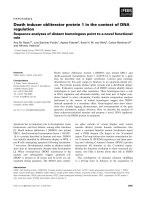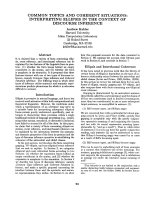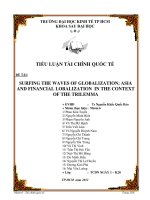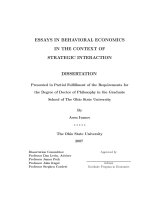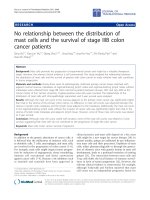Firms’ Investment – Cash Flow Relationship In The Context Of State Ownership And Banking System Reform In Vietnam.
Bạn đang xem bản rút gọn của tài liệu. Xem và tải ngay bản đầy đủ của tài liệu tại đây (914.99 KB, 186 trang )
MINISTRY OF EDUCATION AND TRAINING OF VIETNAM
UNIVERSITY OF ECONOMICS HO CHI MINH CITY
TU THI KIM THOA
Firms’ Investment – Cash Flow Relationship
In The Context Of State Ownership And
Banking System Reform In Vietnam
DOCTORAL THESIS
Ho Chi Minh City, June 2020
1
MINISTRY OF EDUCATION AND TRAINING OF VIETNAM
UNIVERSITY OF ECONOMICS HO CHI MINH CITY
TU THI KIM THOA
Firms’ Investment – Cash Flow Relationship
In The Context Of State Ownership And
Banking System Reform In Vietnam
DOCTORAL THESIS
Specialization: Finance and Banking
Code: 9340201
Supervisors:
VU VIET QUANG, Ph.D.
NGUYEN THI UYEN UYEN, Ph.D.
Ho Chi Minh City, 2020
STATEMENT OF AUTHORSHIP
I hereby declare that this submission is my own work and except where due
reference is made; this thesis contains no material previously published or written
by another person(s).
This thesis does not contain material extracted in whole or in part from a
thesis or report presented for another degree or diploma at University of Economics
Ho Chi Minh City or any other education institution.
Tu Thi Kim Thoa
June 2020
ACKNOWLEDGEMENTS
First and foremost, I would like to express deepest gratitude to my
supervisors, Dr. Vu Viet Quang and Dr. Nguyen Thi Uyen Uyen, for their continual
guidance and mentorship, invaluable support, remarkable patience, useful feedback,
and spiritual encouragement during the completion of my thesis. My thesis can not
be completed without their supervisions, which provided me with much precious
advice to expedite my thesis completion.
I would like to thank the University of Economics Ho Chi Minh City for its
generous financial support of my PhD studies. I also wish to thank all the
colleagues at the UEH School of Finance, School of UEH Graduates and others for
their great and continuing encouragement and full support during my PhD
candidature.
My gratitude also goes to my colleagues at UEH who have constantly given a
great help, support and encouragements to me not only during but also before the
completion of my thesis.
Finally and most importantly, I would like to thank my friends and family for
their
unconditional
love,
immense,
constant
and
endless
support
and
encouragements during my life. I would have been unable to finish the thesis
without their supports and encouragement. And I also wish to dedicate this thesis to
my late mother who is always in my heart.
1
TABLE OF CONTENTS
ABBREVIATIONS............................................................................................ i
LIST OF TABLES............................................................................................ ii
LIST OF FIGURES...........................................................................................v
ABSTRACT.....................................................................................................vi
CHAPTER 1: INTRODUCTION..................................................................... 1
1.1................................................................................................................... Thesis
motivations..................................................................................................... 1
1.2................................................................................................................... Thesis
objectives........................................................................................................ 5
1.3.
Firm’s investment – cash flow relationship in the context of state ownership
in Vietnam................................................................................................................. 5
1.3.1......................................................................................................Objecti
ves and hypotheses................................................................................ 5
1.3.2......................................................................................................Data
6
1.3.3......................................................................................................Metho
dology................................................................................................... 6
1.3.4......................................................................................................Empiri
cal findings............................................................................................ 7
1.3.5......................................................................................................Contri
butions................................................................................................... 7
1.4.
Firm’s investment – cash flow relation in the context of banking system
reform in Vietnam...................................................................................................... 8
1.4.1......................................................................................................Objecti
ves and hypotheses................................................................................ 8
1.4.2......................................................................................................Data
9
1.4.3......................................................................................................Metho
dology................................................................................................... 9
1.4.5. Contributions...................................................................................... 10
1.5................................................................................................................. Thesis
structure........................................................................................................ 10
CHAPTER 2: OVERVIEW ON VIETNAM’S ECONOMIC REFORMS.....11
2
2.1................................................................................................................. Overvie
w on Vietnam’s economy............................................................................. 12
2.2................................................................................................................. Overvie
w on equitization of state owned enterprises of Vietnam.............................. 20
2.3................................................................................................................. Overvie
w on Vietnam’s banking system reform........................................................ 24
2.4................................................................................................................. Chapter
summary....................................................................................................... 29
CHAPTER 3: FINANCIAL CONSTRAINTS AND INVESTMENT: A
THEORETICAL FRAMEWORK AND LITERATURE REVIEW...............31
3.1................................................................................................................. Theories
of investment................................................................................................ 33
3.1.1....................................................................................................The
Modigliani-Miller Theorem (MM)...................................................... 34
3.1.2....................................................................................................Neoclassical model.................................................................................... 34
3.1.3....................................................................................................Sales
accelerator model............................................................................... 35
3.1.4....................................................................................................Tobin’s
Q model............................................................................................... 36
3.1.5....................................................................................................The
Euler model......................................................................................... 38
3.2................................................................................................................. Financia
l constraints and investment: a literature review........................................... 39
3.2.1....................................................................................................Financi
al constraint and investment............................................................... 39
3.2.2....................................................................................................State
Ownership and Investment–Cash Flow Relations............................... 48
3.2.3....................................................................................................Banking
system reform and investment – cash flow relation.............................50
3.2.4....................................................................................................Financi
al leverage, growth opportunity and investment relation....................51
3.3................................................................................................................. Chapter
summary....................................................................................................... 53
CHAPTER 4: FIRM’S INVESTMENT – CASH FLOW RELATIONSHIP IN
THE CONTEXT OF STATE OWNERSHIP IN VIETNAM..........................54
4.1................................................................................................................. The
study introduction......................................................................................... 55
4.2................................................................................................................. Literatur
e review and hypothesis development.......................................................... 57
4.2.1....................................................................................................Relation
between investment and cash flow....................................................... 57
4.2.2....................................................................................................State
Ownership and Investment–Cash Flow Relations............................... 60
4.2.3....................................................................................................State
Ownership and Investment–Leverage Relation................................... 62
4.3................................................................................................................. Researc
h design........................................................................................................ 63
4.3.1....................................................................................................Testing
Investment–Cash Flow Relation.......................................................... 63
4.3.2.
Testing the Impact of State Ownership on Investment–Cash Flow
Relations
66
4.3.3.
Testing the Impact of State Ownership on Investment–Leverage
Relations
67
4.3.4....................................................................................................Data
67
4.4................................................................................................................. Empiric
al results....................................................................................................... 68
4.4.1....................................................................................................Descript
ive Statistics........................................................................................ 68
4.4.2....................................................................................................Empiric
al Results............................................................................................. 70
4.4.3....................................................................................................Robustn
ess Check............................................................................................. 83
4.5................................................................................................................. Conclusi
on.................................................................................................................. 92
4.6................................................................................................................. Chapter
summary....................................................................................................... 93
CHAPTER 5: FIRM’S INVESTMENT – CASH FLOW RELATIONSHIP
UNDER THE CONTEXT OF BANKING SYSTEM REFORM IN
VIETNAM.......................................................................................................94
5.1................................................................................................................. The
Stuty Introduction......................................................................................... 95
5.2................................................................................................................. Literatur
e review........................................................................................................ 98
5.2.1....................................................................................................Investm
ent – cash flow relation....................................................................... 98
5.2.2.
Effect of banking system reform on investment – cash flow relation.100
5.3. Research methodology............................................................................... 101
5.3.1..................................................................................................Hypothes
is development and model specification............................................ 101
5.3.2..................................................................................................Data 106
5.4............................................................................................................... Empirical
results......................................................................................................... 107
5.4.1..................................................................................................Descripti
ve statistic......................................................................................... 107
5.4.2..................................................................................................Correlati
ons..................................................................................................... 109
5.4.3..................................................................................................Regressio
n results............................................................................................. 111
5.4.4..................................................................................................Robustne
ss check............................................................................................. 129
5.5............................................................................................................... Study
conclusion.................................................................................................. 130
5.6............................................................................................................... Chapter
summary..................................................................................................... 131
CHAPTER 6: CONCLUSION......................................................................133
6.1............................................................................................................... Introducti
on................................................................................................................ 133
6.2.
Firm’s investment – cash flow relationship in the context of state ownership
in Vietnam............................................................................................................. 133
6.2.1..................................................................................................Research
findings............................................................................................. 133
6.2.2.
.134
Research contributions, implications and policy recommendations
6.2.3..................................................................................................Research
limitations and future research directions......................................... 136
6.3.
Firm’s investment – cash flow relationship in the context of banking system
reform in Vietnam.................................................................................................. 137
6.3.1..................................................................................................Research
findings............................................................................................. 137
6.3.2.
138
Research contributions , implications and policy recommendations
6.3.3..................................................................................................Research
limitations and future research directions......................................... 140
LIST OF AUTHOR’S PUBLICATIONS......................................................141
REFERENCES..............................................................................................142
APPENDIX...................................................................................................148
1
ABBREVIATIONS
Agribank
Vietnam Bank for Agriculture and Rural
Development
ASEAN
Association of Southest Asian Nations
ATFA
ASEAN Free Trade Agreement
BIDV
Bank for Investment and Development of Vietnam
CPI
Comsumer Price Index
FDI
Foreign direct investment
GDP
Gross Domestic Products
HCMC
Ho Chi Minh City
HNX
Hanoi Stock Exchange
HOSE
Ho Chi Minh City Stock Exchange
JSCB
Joint-stock commercial bank
JVB
Joint – venture bank
MM
Modigliany and Miller Theorem
SBV
State Bank of Vietnam
SOCB
State-owned commercial bank
SOE
State owned enterprise
US
United States of America
VCB
Bank for Foreign Trade of Vietnam
Vietinbank
Vietnam Industrial and Commercial Banks
WTO
World Trade Organization
LIST OF TABLES
Table 2.1
Main economic indicators of Vietnam, 1986 – 2018
19
Table 2.2
Stages of SOE equitization in Vietnam (1992 – 2018)
21
Table 2.3
Credit institutions of Vietnam, 2010 - 2017
26
Table 2.4
Foreign banks’ branches in Vietnam
27
Table 3.1
Summary of Financial Constraint Proxies
47
Table 4.1
Sample structure
68
Table 4.2
Variable descriptive statistic
69
Table 4.3
Differences between non state-owned and state-owned
70
enterprises
Table 4.4
Analysis of relation between investment and cash flow
73
Table 4.5
Impact of state ownership on investment – cash flow
76
relation
Table 4.6
Impact of state ownership on relation between investment
78
and cash flow under different growth opportunities
Table 4.7
Impact of state ownership on the investment and leverage
81
relations
Table 4.8
Impact of state ownership on the relations between
investment - leverage under different growth opportunities
82
Table 4.9
State ownership and relations between investment and cash
84
flow under different growth opportunities: GMM
estimation method
Table 4.10
Classification of state-owned and non-state-owned
87
enterprises using the threshold of 33.15 percent
Table 4.11
State ownership and relations between investment and cash
90
flow under different growth opportunities in which high
growth opportunity is classified by quartile
Table 5.1
Sample structure
107
Table 5.2
Variable descriptive statistic
108
Table 5.3
Pearson and Spearman correlation matrix
110
Table 5.4
Analysis of investment - cash flow relation
115
Table 5.5
Effect of banking system reform on investment – cash flow
Table 5.6
relation
Effect of banking system reform on investment –cash flow
119
122
relation of state – controlled listed companies by different
Table 5.7
growth opportunities.
Effect of banking system reform on investment –cash flow
relation of non state – controlled companies by different
growth opportunities
124
Table 5.8
Effect of banking system reform on investment – leverage
126
relation
Table 5.9
Effect of banking system reform on investment – leverage
128
relation for both low and high growth opportunities
Table 5.10
GMM estimates of investment – cash flow sensitivity
129
LIST OF FIGURES
Figure 2.1
Annual GDP growth rate for the period of 1986 – 2018 (%)
13
Figure 2.2
Vietnam’s Inflation (% change of CPI), 1986-2018
15
Figure 2.3
Vietnam’s volume of imports and exports (% of GDP),
16
1986-2018
Figure 2.4
Vietnam’s Foreign Direct Investment, net inflows (% of
18
GDP)
Figure 2.5
Progress of SOE equitization, 1992 – 2018
22
Figure 2.6
Number of SOEs, 1995 - 2017
24
Figure 5.1
Fitted value of investment (IK) on cash flow (CFK) on a
112
full sample of Vietnamese listed firms for the period of
2009 – 2014
Figure 5.2
Fitted value of investment (IK) on cash flow (CFK) on a
113
subsample of Vietnamese State controlled firms for the
period of 2009 - 2014
Figure 5.3
Fitted value of investment (IK) on cash flow (CFK) on a
subsample of Vietnamese Non - state controlled firms for
the period of 2009 - 2014
114
ABSTRACT
This thesis applies the style of a series of papers in the field of corporate
finance, which mainly composes of the two stand-alone essays.
The first essay investigates the effect of state ownership on the relationship
between investment and cash flow in Vietnam, a small transitional economy. Using
a sample of companies listed on the both Ho Chi Minh City Stock Exchanges
(HOSE) and Hanoi Stock Exchange (HNX) during the period 2008 to 2015, the Ushaped investment–cash flow relations for both state-owned and non-state-owned
firms are found. In addition, state-owned companies (SOEs) have higher cash flow
sensitivity of investment, which perhaps is due to their socioeconomic and political
responsibilities, poor corporate governance and agency problem. Their growth
opportunities also affect the sensitivity.
The second essay examines the effect of banking system reform, which is
defined by the presence of foreign banks, on investment-cash flow relation in a
context of a small transition economy. I find evidence that the presence of foreign
banks in Vietnam results in decreasing in firm’s dependence on local banks and has
changed their financial constraint. Company investments are less reliant on internal
cash flow in the post reform period. Although overinvestment of state controlled
firms can not be reduced but underinvestment problem of non- state -controlled
listed firms is mitigated due to better accessibility to bank loans. The investigated
relation between investment and leverage is robust for this conclusion.
JEL classification: G30, G31, G32
Keywords: financial constraints, investment – cash flow relations, state ownership,
banking system reform, small transition economy.
1
CHAPTER 1
INTRODUCTION
This thesis applies the style of a series of papers in the field of corporate
finance, which mainly composes of the two stand-alone essays. This chapter
summarizes the content of the thesis, which brieftly presents the thesis’ motivations,
objectives, methodologies, contributions and structure. Section 1.1 presents the
thesis motivations on impact of financial constraints, particularly state ownership
and banking system reform on firm’s investment – cash flows of a transition
economy, Vietnam. Section 1.2 introduces the research objectives. Section 1.3 and
Section 1.4 respectively summarize the two essays: firm’s investment – cash flow
relation under the context of state ownership in Vietnam and firm’s investment –
cash flow relation under the context of banking system reform in Vietnam. Finally,
Section 1.5 presents the structure of the thesis.
1.1. Thesis motivations
The thesis was inspired by the following motivations:
Firstly, investment is one of the most important decisions in corporate
financial decisions. The company managers will make all of efforts to conduct
positive NPV investment opportunities because these investmens are expected to
increase the firm value. Beside availability of positive NPV investment
opportunities, the availability of financing funds (internal or/and external) is another
important factor affecting the firm’s investments. Therefore, relationship between
investment and cash flows, especially in the context of financial constraints have
attracted
interests of many scholars. Fazzari, Hubbard, Petersen, Blinder, and Poterba (1988)
show that financially contrained firms have high investment – cash flow
sensitivities because of higher cost of external funds in compared with that of
internal funds. Different types of the relationhip between investment and cash flow
have been found in financial literatures. Fazzari et al. (1988) find the linear
relationship while Cleary, Povel, and Raith (2007) document the non-linear (Ushaped) ones, which have been confirmed by many other studies (Firth, Malatesta,
Xin, & Xu, 2012; Guariglia, 2008; Tsai, Chen, Lin, & Hung, 2014). So, there is no
consistent relation between investment and cash flows found in the literatures.
Moreover, the relation has not been under-investigated for Vietnam context.
Secondly, the investment – cash flow sensitivity is one of commonly used
measures of financial constraint which is defined as a limit in capital accessibility,
either internally or externally. In the context of transition economy like China and
Vietnam, the role of state ownership on financial constraints has been unclear. Many
studies shows evidence that state-ownership does have impact on firm financial
constraints, i.e. investment – cash flow relation (Firth et al., 2012; Haider, Liu,
Wang, & Zhang, 2018; Tsai et al., 2014) while H.-C. M. Lin and Bo (2012) shows
that state
– ownership does not help to reduce financial constraints on investment even via the
state-controlled banking system.
Vietnam used to follow the centrally-planned economy which was entirely
dominated by state-owned enterprises (SOEs). This mechanism led the country into
crisis and backward, which required a broad and in–depth renovation of the whole
economy. A comprehensive program which is well-known as Doi moi was
introduced in 1986 to transform the economy from a socialist to a market oriented.
As one of the components of the Doi moi policy, an equitization (privatization perse) program launched in the early 1990s has transformed a number of state-owned
companies into joint-stock companies beside for the first time allowing existence of
private companies. A number of private companies (both equitized and nonequitized) has
been constantly increasing. However, the government still plays an important role in
a large number of companies by holding a large percentage of outstanding shares at
many equitized SOEs. In the literatures, the impact of state ownership on firm
performance as well as financial decisions is still controversial. Sun and Tong
(2003) report that the privatization program in China improved earnings, sales, and
workers’ productivity at Chinese SOEs but not profitability. Du and Boateng (2015)
assert that shareholder value is significantly affected by state ownership, formal
institutional distance, and reforms in the foreign currency approval system.
However, G. Chen, Firth, and Xu (2009) find that firm performance is enhanced by
certain types of state ownership. SOEs have slow, even negative growth whereas the
rapidly growing private sector significantly contributes to economic growth (Allen,
Qian, & Qian, 2005). It finds that SOEs with a soft budget constraint can easily
access external financing, resulting in lower dependence on internal cash flows than
is the case at privately owned firms (Allen et al., 2005; Cull & Xu, 2003). Firth et
al. (2012) also report that state ownership has an impact on the relation between
investment and cash flow. R. R. Chen, El Ghoul, Guedhami, and Nash (2018) assert
that an increase in state ownership leads to an increase in corporate cash holdings,
which means a positive relation between government ownership and corporate cash
holdings. More specifically, SOEs have higher investment–cash flow sensitivity
than privately owned firms, especially when cash flow is negative. So, whether state
ownership has any impact on corporate financial constraint, specifically, investment
– cash flow relation of Vietnamese companies is still an unanwered question.
Thirdly, in Vietnam, due to the underdevelopment of financial market, beside
internal cash flows, bank loans have been main financing sources of funds for firm’s
investments. However, credit market is not a fair play ground for private companies
due to some historical reasons1 although Vietnam has done several efforts to
improve
1
Vietnam used to be a centrally-planned economy in which state – owned banks mainly served for state-owned
enterprises.
the situation. Nhung and Okuda (2015) show that Vietnamese SOEs have an
advantage over privately owned firms in accessing bank loans as well as making a
profit, even after economic booms. The higher accessibility to bank loans, the less
financially constrained the firm is, meaning the lower investment – cash flow
sensitivity. Therefore, banking system reform is proved to have an impact on
investment – cash flow relation (Tsai et al., 2014). In the process of transforming
the economy from centrally – planned to market oriented, Vietnam also has
conducted a number of financial system reforms as a component of overal economic
reform. One of them is to allow the entry of foreign banks to do business in
Vietnam. This does not only come from the reality but from entrance requirements
of international free trade agreements such as WTO also. The presence of foreign
banks on one side would increase competition in credit market, and on the other
side put pressures on domestic banks to improve their transparancy, effeciency and
profitability to be survival and grow in a integrated market. As such, the presence of
foreign banks – which can be considered a measure to reform the banking system –
may have certain impact on companies accessibility to external funds to finance
their investment, or on the other words, firm’s investment – cash flow relation.
Therefore, it also motivates me to conduct this thesis.
The topic of investment – cash flows have been intensively conducted in
financial literatures, but most of them use the samples of developed countries like
U.S, Canada, or China – a big transitional economy. To my best knowledge, the
relationship between investment and cash flows, especially in the context of state –
ownership and foreign bank entry has still not investigated for the case of a small
transition economy like Vietnam. Furthermore, in spite of sharing some cutural,
social and political similarities with China, Vietnam also has many differences such
as size of economy, history of the transformation, openness to the world economy,
development of financial market, etc. Studying the Vietnamese context is believed
to be worthwhile and valuable for international finance literatures because results
form
the rather specific case of China may not be generalizable for other small emerging
markets. Therefore, I choose to examine the impact of banking system reform, and
state ownership on investment – cash flow sensitivity in Vietnam for my Ph.D
thesis.
1.2. Thesis objectives
The general objective of the research is to investigate the impact of financial
constraints, which are measured by state ownership and banking system reform on
the relation between firm’s investment and internal cash flows in the context of
small transitional economy – Vietnam. The general objective is implemented by the
two essays which are separately presented in the following Sections of 1.3 and
Section 1.4.
1.3. Firm’s investment – cash flow relationship in the context of state
ownership in Vietnam
1.3.1.
Objectives and hypotheses
The study examines the effect of state ownership on the relationship between
investment and cash flow in Vietnam, a small transitional economy. The study
objectives are as follows:
- Examine the nonlinear relationship (U-shape) between investment and
cash flows of Vietnamese listed companies.
- Examine impact of state ownership on the investment – cash flow relation
in general, and for state controlled and non –state controlled firms.
- Examine impact of state ownership on the investment – leverage relation
in general, and for state controlled and non –state controlled firms.
- Propose some policy reccommendations to various related parties based
on the research findings
To achieve the research objectives, following research questions are set forth:
-
Does the investment and cash flow relation of Vietnamese
companies have U-shape?
-
Do state controlled companies have higher investment–cash
flow sensitivity than non-state controlled companies?
- Does state ownership has a positive impact on a firm’s
investment– debt relations.
1.3.2.
Data
The final sample of the study consists 3,366 firm-year observations of nonfinancial companies listed on the two stock exchanges of Vietnam, HOSE and HNX
for the period of 2009 – 20152. Both financial and market data are extracted from
the Thomson Reuters database. Observations with missing data are omitted, and
outliers that may influence the results are also excluded by winsorizing 1% of the
two tails for each variable.
1.3.3.
Methodology
The study applies quantitative method. First, the study tests if investment –
cash flow in Vietnam is U-shaped for Vietnamese firms in genternal, state
controlled and state uncontrolled firms, employing two different approaches. The
first approach follows Cleary et al. (2007) which includes square of cash flow
method in the standard investment regression equation developed by Fazzari et al.
(1988), and the second approach follows Firth et al. (2012) which separates cash
flows into positive and negative cash flows.
Secondly, the impact of state
ownership on the investment
– cash flow relationship is investigated by using both dummy and continuous
variables of state ownership. The investigation is conducted for the full sample,
state
2
The period is chosen because there were just a limited number of listed equitized SOEs before 2008 and the
study was conducted in 2016.
controlled, state-uncontrolled subsamples as well as high and low growth
opportunities sub-subsamples. Thirdly, the investment-leverage relationship is also
examined in the same manner. All the regressions are estimated by using
Generalized Least Squared (GLS) method on a panel data samples to control for the
heteroscedasticity problem and robusted by Generalized Method of Moment
(GMM) for endogeneitity potential.
1.3.4.
Empirical findings
The results show that the investment–cash flow relation for both state-owned
and non-state-owned firms is U-shaped. In addition, state-owned companies have
higher cash flow sensitivity of investment, which perhaps is due to their
socioeconomic and political responsibilities, poor corporate governance and agency
problem. Moreover, the investment of high-growth companies, both with and
without state ownership, has lower dependence on internal cash flow. Additionally,
low- growth state-owned companies have higher cash flow sensitivity of investment
than those without state ownership, suggesting inefficient investment by the former.
1.3.5.
Contributions
The following contributions are added into the current literature from
different perspectives. First, I shed further light on the implications of financial
constraints by investigating the association between state ownership and corporate
investment–cash flow in a small transitional economy such as Vietnam. Second,
generally previous studies examining this important issue have been conducted in
the context of developed countries or China (Cleary et al., 2007; Firth et al., 2012;
Tsai et al., 2014). The intensive literature review has indicated that the impact of
state ownership on investment relations in an emerging and transitional country
such as Vietnam has largely been under-examined.
1.4. Firm’s investment – cash flow relation in the context of banking
system reform in Vietnam
1.4.1.
Objectives and hypotheses
The study examines the effect of banking system reform on investment-cash
flow relation in a context of a small transition economy. The banking system reform
is measured by presence of foreign banks or their branches, outlets, representative
offices at the location where the company locates its headquarter. Followings are the
study objectives:
- Examine the U-shape relationship between investment and cash flow for
Vietnamese companies.
- Examine impact of banking system reform on the investment – leverage
relation in general, and for state controlled and non –state controlled firms.
- Examine impact of banking system reform on the investment – leverage
relation in general, and for state controlled and non –state controlled firms.
- Propose some policy reccommendations to various related parties based
on the research findings
To achieve the research objectives, following research questions are set forth:
-
Is there a nonlinear investment – cash flow relation (U-shape) at
Vietnamese companies?
-
Does banking system reform mitigate overinvestment problem at state –
controlled companies?
-
Does banking system reform mitigates underinvestment problem at non state
– controlled companies?
-
Does banking system reform has a positive impact on firm’s
investment – debt relation?

